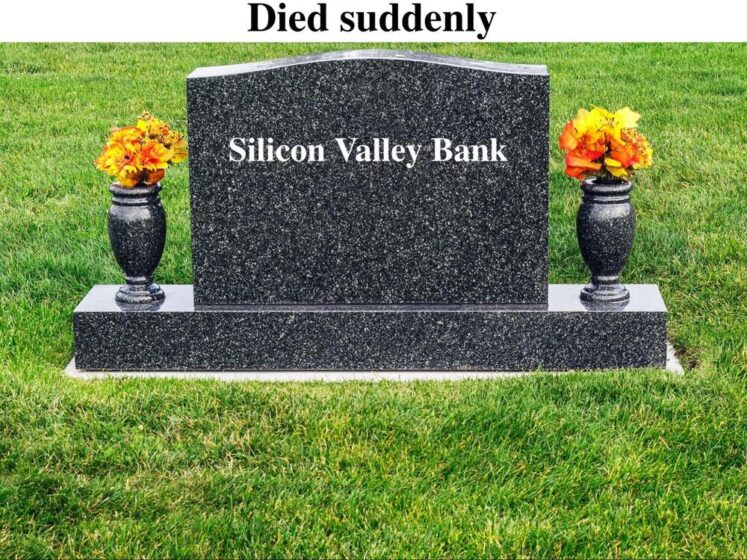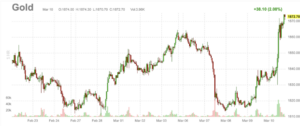
You have probably heard it by now but Silicon Valley Bank went tits up, making it the second largest bank failure in America’s history. I know what it was. The “climate changed,” specifically bonds, which we’ll come to in a minute.
For a moment, it looked like anyone with over $250,000 in the bank would lose their money. Apparently more than 90% of deposits at SVB exceeded this figure. That was the situation until the Fed came in and bailed everyone out over the weekend.
A timely reminder that money in the bank is NOT YOURS.
You are an unsecured creditor in what may very well be an insolvent institution. Some countries don’t even have deposit insurance, and every penny can be taken.
Meanwhile, here’s a live shot of me surveying my gold hoard (very little in banks):
In all seriousness, the issue here for SVB is actually with bonds.
Jamie Quint explained this on Twitter:
– In 2021 SVB saw a mass influx in deposits, which jumped from $61.76bn at the end of 2019 to $189.20bn at the end of 2021.
– As deposits grew, SVB could not grow their loan book fast enough to generate the yield they wanted to see on this capital. As a result, they purchased a large amount (over $80bn!) in mortgage backed securities (MBS) with these deposits for their hold-to-maturity (HTM) portfolio.
– 97% of these MBS were 10+ year duration, with a weighted average yield of 1.56%.
– The issue is that as the Fed raised interest rates in 2022 and continued to do so through 2023, the value of SVB’s MBS plummeted. This is because investors can now purchase long-duration “risk-free” bonds from the Fed at a 2.5x higher yield.
– This is not a liquidity issue as long as SVB maintains their deposits, since these securities will pay out more than they cost eventually.
– However, yesterday afternoon, SVB announced that they had sold $21bn of their Available For Sale (AFS) securities at a $1.8bn loss, and were raising another $2.25bn in equity and debt. This came as a surprise to investors, who were under the impression that SVB had enough liquidity to avoid selling their AFS portfolio.
Basically, SVB made a fixed income investment, rates moved higher, decimating the value of those bonds and now their collateral base is crappy. They’d need to sell assets to shore up their balance sheet, call in loans, raise equity, or all of the above — none of which is accretive and all of which may in itself call into question the solvency of the bank. Well, as it turns out, they waited too long to do any of that to try to fix things. And now they’re gone.
As we’ve been saying for years now, the unwinding of the bond market is going to create all manner of problems, many of which we’ve not even thought about. Anyone who is long bond duration is going to get hammered. The knock on effects promise to be substantial.
What to look out for? Banks, Insurances and Pension Funds.
Banks, insurance companies, and pension funds all own long-term paper at extremely low interest rates. Increasingly, they’ll be forced to compete with short-term treasuries, and they’ll lose. This is without them marking to market their balance sheets, which will come under enormous pressure. Consider a bond bought with a 1.25% coupon. When that same bond yields a mere 2.5%, the value of the bond gets cut in HALF. That’s a problem as all three of the above institutions will be forced to do one or all of the following in order to meet capital adequacy ratios:
- Raise equity capital, which is dilutive and will be taking place in an environment of risk aversion. Ouch!
- Liquidate some portion of their book in order to bring things back into line. Calling in loans in the midst of a market that is “risk off” means liquidity is poor or poorer than previously thought and prices crater quickly, especially with illiquid assets (think real estate, private equity, and so forth).
- Seek a saviour from a better capitalised competitor in order to stay alive. Naturally, any transaction like this will be done on terms rather favourable to the acquirer. Call it distressed debt investing.
But what retail does? Buy more of those.
Remember, retail investors have no idea about any of the above. All they see is headlines on the nightly news and they freak out. This is why “managing the press” is so important to the powers that be. If not “managed,” we see mass withdrawals from depositors seeking higher yields which itself results in a wave of bank failures and that itself results in further withdrawals. Did I mention you may want to hold some gold?
In any event, the market sensing risk immediately sold the banks. All of them.
To be fair, every major index was down. The Dow, the Spooz, Nasdaq — all of them.
We don’t particularly care since we’re not invested in banks. With respect to the indices, we’re not invested in these either. This doesn’t mean however that we couldn’t see some headwinds as a liquidity crisis could cause problems for all and sundry here.
Interestingly that “useless lump of rock” took a few blue pills and got a rise.
The Coming Implosion
Give it 12 months or less, as the venture capitalists’ books are going to begin to be forced to mark-to-market their positions is going to be epic. I say they’re going to be forced to do this because most VC funded firms have 12 months of runway, and pray tell, who’s going to keep lending money to mostly (not all mind) cash incinerating Silicon Valley startups? So start your stopwatches and let’s clock back in 12 months from now or so (probably less).
Take a look at this Joint Statement by Treasury, Federal Reserve, and FDIC
The following statement was released by Secretary of the Treasury Janet L. Yellen, Federal Reserve Board Chair Jerome H. Powell, and FDIC Chairman Martin J. Gruenberg:
Today we are taking decisive actions to protect the U.S. economy by strengthening public confidence in our banking system. This step will ensure that the U.S. banking system continues to perform its vital roles of protecting deposits and providing access to credit to households and businesses in a manner that promotes strong and sustainable economic growth.
After receiving a recommendation from the boards of the FDIC and the Federal Reserve, and consulting with the President, Secretary Yellen approved actions enabling the FDIC to complete its resolution of Silicon Valley Bank, Santa Clara, California, in a manner that fully protects all depositors. Depositors will have access to all of their money starting Monday, March 13. No losses associated with the resolution of Silicon Valley Bank will be borne by the taxpayer.
We are also announcing a similar systemic risk exception for Signature Bank, New York, New York, which was closed today by its state chartering authority. All depositors of this institution will be made whole. As with the resolution of Silicon Valley Bank, no losses will be borne by the taxpayer.
Shareholders and certain unsecured debtholders will not be protected. Senior management has also been removed. Any losses to the Deposit Insurance Fund to support uninsured depositors will be recovered by a special assessment on banks, as required by law.
Finally, the Federal Reserve Board on Sunday announced it will make available additional funding to eligible depository institutions to help assure banks have the ability to meet the needs of all their depositors.
The U.S. banking system remains resilient and on a solid foundation, in large part due to reforms that were made after the financial crisis that ensured better safeguards for the banking industry. Those reforms combined with today’s actions demonstrate our commitment to take the necessary steps to ensure that depositors’ savings remain safe.
Imagine being a conservative bank that did the right thing. You now pay for the folly of your competitors who completely pha-cdup. Communism.
The little midget woman assured everyone that this is NOT a bailout. So there’s that.
SVB is a warning sign not an isolated event.
It is a function of the risks that are out there. Anyone with long duration fixed income assets bought anywhere from 2008 onwards is holding increasingly worthless paper. The ramifications of this will be profound.
What nobody is talking about, and for the life of me, I can’t figure out why, is that this has implications on the international front. Imagine, for a moment, you’re China. You see all this going down. You realize that the Fed can’t “tame inflation” while simultaneously bailing out the banks. It’s one or the other, and they’ve just announced they’ll bail out the banks. It is worth remembering China holds roughly a trillion in US debt.
Now, add to that the neocons threatening war with China, and you can see that there is a non zero risk that China tries to get out of the kitchen first and sells their US bonds. I know that’s what I’d do.
For whatever is worth, my favorite bank in this environment is something akin to Gringotts.
Editor’s Note: The Western system is undergoing substantial changes, and the signs of moral decay, corruption, and increasing debt are impossible to ignore. With the Great Reset in motion, the United Nations, World Economic Forum, IMF, WHO, World Bank, and Davos man are all promoting a unified agenda that will affect us all.
To get ahead of the chaos, download our free PDF report “Clash of the Systems: Thoughts on Investing at a Unique Point in Time” by clicking here.









